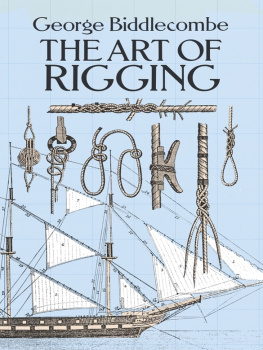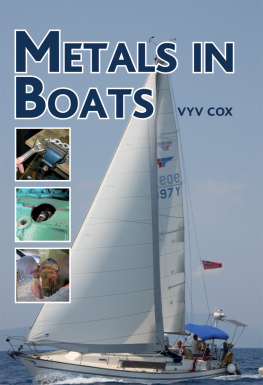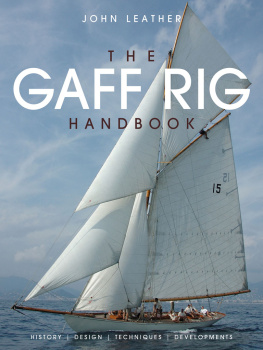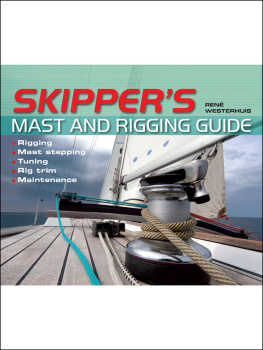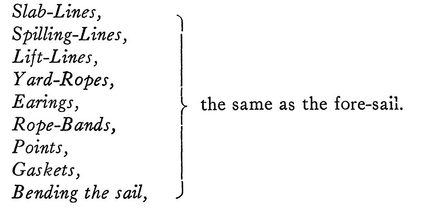A DESCRIPTION OF REEVING THE RUNNING RIGGING AND BENDING THE SAILS; ALSO THE RIGGING OF BRIGS, YACHTS, AND SMALL VESSELS
REEVING THE GEAR AND BENDING THE FORE-SAIL (Pl. 12, fig. 1)
The Tack and Sheet Blocks are put over the clues, or shackled to it, on each side, and the strap of the clue-garnet block put through the clues; the eyes are brought up on each side, and seized.
Sheets are rove through the sheet-blocks on each side, and the standing-part seized to a thimble, in an eye-bolt, a little before the gangway. The leading-part leads through a sheave-hole a little before the gangway; then leads forward, and belays round a large cleat in the side.
Tacks , when double. The standing-part is clinched or spliced round the outer end of the bumpkin, and the leading-part leads through a single-block in the clue of the sail, then through a block at the outer end of the bumpkin, and leads in upon the forecastle.
Clue-Garnets reeve through the blocks on each side the yard, then through the block on the clue of the sail. The standing-part is carried up, and made fast round the yard by its block. The leading-part comes upon deck, and reeves through the sheave-hole in the top-sail-sheet bitts, and there belays.
Leech-Lines reeve through the block under the top; then through the block upon the yard, and the standing-part toggles to the leech-cringle, or leads through the leech-cringles up abaft the sail, to the yard; the leading-part then leads through a block, at the aft-part of the top, and comes down upon the forecastle.
Bunt-Lines reeve through a double-block at the aft-part of the top; then through another block under the fore-part of the top, and through the blocks or lizards on the yard, then down on the fore-side of the sail, and toggle or clinch to the cringles in the foot. The hauling-part leads on deck.
Bowlines reeve through a single-block lashed at the collar of the fore-stay, on the bowsprit, the outer part with a thimble spliced in the end, through which thimble the bridle is rove, when the bridle clinches to the cringle on the leech of the sail. The leading-part leads upon the forecastle.
Slab-Lines reeve through a small block, lashed to the span of the quarter-blocks, and the standing-part toggles or clinches with two legs to the middle bunt-line cringles. The leading-part leads to the top-sail-sheet bitts.
Spilling-Lines (when used) reeve through blocks, lashed on each side of the quarter-blocks of the lower yards, then lead down before the sail, return upwards under the foot of the sail, and make fast round the yard with a timber-hitch.
Life-Lines are sometimes used for the preservation of the men, and make fast round the lift, or the strap of the lift-block and jeer, or tie-blocks, in the middle of the yard.
Yard-Ropes are temporary, and only used to get the sail up for bending; they are made fast round the boom-iron at each yard-arm, and one end comes down and makes fast to the first reef-earing. The leading-part leads upon deck.
Earings, one end of which is spliced to the head-cringle, with a long eye; the other end passed over the yard-arm without the rigging, through the cringle, alternately, two or three times, and is passed round the yard within the rigging, and through the cringle, till the earing is expended, and the end made fast with two half-hitches. The outer turns are to stretch the upper edge of the sail tight along the yard, and the inner turns to draw it close.
Reef-Earings the same.
Rope-Bands are rove through the eyelet-holes in the head of the sail, by which it is made fast to the jackstays.
Points are put in the sail, thus: An over-hand knot is made in the middle of the point, then thrust through the eyelet-hole in the reef-band, and knotted close to the sail on the opposite side. Sometimes they are sewed in; at others, when in two parts, by reeving the ends through the eyelet-hole in the sail, and through the eye of each other, and jambed home with sheaves.
Gaskets go round the jackstays with a running-eye, two at each quarter, and one on each yard-arm, with a bunt-gasket in the middle.
The Fore-sail being ready, lay it athwart the forecastle; reeve the tacks, sheets, clue-garnets, bunt-lines, leech-lines, bowlines, and slab-line; see the rope-bands and earings all complete, then hook the yard-ropes (or small tackles) to the first reef-cringle; run the sail up to the yard, pass the earings, and fasten the sail to the jackstays by the rope-band, then see the gaskets and reef-earings clear.
REEVING THE GEAR AND BENDING THE MAIN-SAIL (Pl. 12, fig. 2)
Sheet, Tack, and Clue-Garnet Blocks , are placed in the clues as for the fore-sail.
Sheets reeve through the sheet-block at the clues. The standing-part is seized to an eye-bolt with a thimble on the quarters. The leading-part leads through a sheave-hole on the same side, on the upper deck, and belays to a large cleat in the ships side.
Tacks , when double. The standing-part clinches or hooks to an eye-bolt before the chestree, and the leading-part leads through a single-block in the clue of the sail; then leads through the sheave in the chestree on deck, and belays to a kevel in the side.
Clue-Garnets and Leech-Lines, as the fore-sail.
Bunt-Lines, as the fore-sail, but lead down the main-stay to the forecastle, in large ships.
Bowlines . A tackle is fitted on purpose for the bowline, which toggles to the bowline cringle, and the single-block near the fore-mast, by which tackle it is bowsed out.
REEVING THE GEAR AND BENDING THE SPANKER (Pl. 12, fig. 12)
Ships, when fitted with the spanker to brail up, have brail-blocks strapped together, and laid over the gaff, and seized together underneath; the throat blocks next the mast, the middle blocks between the throat and peak, the foot-brail blocks about one-third from the tack of the sail, upwards. (Pl. 7, fig. 8).
Vangs are fitted over the gaff-end; have a purchase, which hooks to an eye-bolt in the quarter-piece on each side.
Signal or Ensign Halliard Blocks are seized in the eye-bolt at the end of the gaff. (Pl. 7, fig. 8).
Ships or Brigs working the gaff on the mast without brails, have a dawnhauler, which is fitted near the outer earing of the sail.
The Spanker being ready to bend, lower the gaff, reeve both the earings, and ride the head of the sail to stretch it; then secure the earings, and reeve the lacing, seize the mast-hoops to the eyelet-holes in the luff of the sail, reeve the brails and outhauler, and hook the tack-tackles.
REEVING THE GEAR AND BENDING THE JIB (Pl. 11, fig. 2)
The Downhauler reeves through a small block that lashes to the traveller on the jib-boom, then leads up a few of the hanks, and bends to the head of the jib. The leading-part leads in upon the forecastle.
The Halliards reeve through a block at the fore-top-mast-head, from aft on the starboard side, and bend to the head of the sail. The leading-part leads abaft the top to the after-part of the forecastle. Large ships have double halliards.
Pendants and Sheets . The bight of the pendant is lashed to the clue of the sail, and a single-block turned in each end that reeves the sheets, the standing-part of which makes fast to a bolt in the bows, and the leading-part leads through a block on the forecastle, and belays to a cleat.

